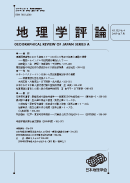Volume 82, Issue 4
Displaying 1-14 of 14 articles from this issue
- |<
- <
- 1
- >
- >|
ORIGINAL ARTICLES
-
Article type: Original Article
2009 Volume 82 Issue 4 Pages 277-299
Published: July 01, 2009
Released on J-STAGE: August 25, 2011
Download PDF (1130K) -
Article type: Original Article
2009 Volume 82 Issue 4 Pages 300-322
Published: July 01, 2009
Released on J-STAGE: August 25, 2011
Download PDF (743K)
RESEARCH NOTES
-
Article type: Research Note
2009 Volume 82 Issue 4 Pages 323-331
Published: July 01, 2009
Released on J-STAGE: August 25, 2011
Download PDF (536K) -
Article type: Research Note
2009 Volume 82 Issue 4 Pages 332-345
Published: July 01, 2009
Released on J-STAGE: August 25, 2011
Download PDF (677K) -
Article type: Research Note
2009 Volume 82 Issue 4 Pages 346-355
Published: July 01, 2009
Released on J-STAGE: August 25, 2011
Download PDF (1137K)
BOOK REVIEWS
-
Article type: Book Review
2009 Volume 82 Issue 4 Pages 356-358
Published: July 01, 2009
Released on J-STAGE: August 25, 2011
Download PDF (314K) -
Article type: Book Review
2009 Volume 82 Issue 4 Pages 358-359
Published: July 01, 2009
Released on J-STAGE: August 25, 2011
Download PDF (310K) -
Article type: Book Review
2009 Volume 82 Issue 4 Pages 359-360
Published: July 01, 2009
Released on J-STAGE: August 25, 2011
Download PDF (311K)
MISCELLANEOUS RECORDS
-
2009 Volume 82 Issue 4 Pages 361-373
Published: July 01, 2009
Released on J-STAGE: August 25, 2011
Download PDF (507K) -
2009 Volume 82 Issue 4 Pages 374-376
Published: July 01, 2009
Released on J-STAGE: August 25, 2011
Download PDF (205K) -
2009 Volume 82 Issue 4 Pages 377-381
Published: July 01, 2009
Released on J-STAGE: August 25, 2011
Download PDF (322K) -
2009 Volume 82 Issue 4 Pages 382-384
Published: July 01, 2009
Released on J-STAGE: August 25, 2011
Download PDF (596K) -
2009 Volume 82 Issue 4 Pages 385-388
Published: July 01, 2009
Released on J-STAGE: August 25, 2011
Download PDF (251K) -
2009 Volume 82 Issue 4 Pages 4_cover2-cover3
Published: July 01, 2009
Released on J-STAGE: August 25, 2011
Download PDF (205K)
- |<
- <
- 1
- >
- >|
